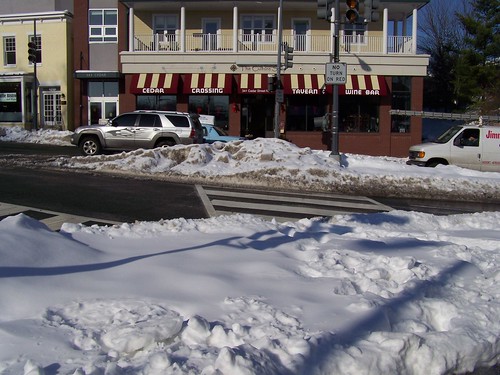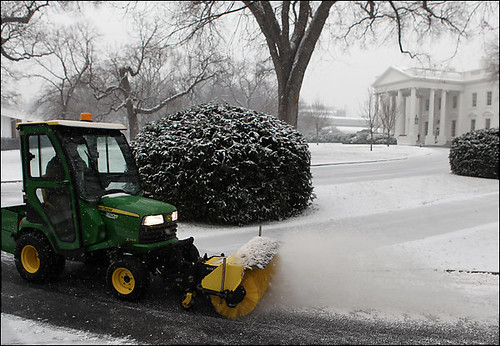Walk this way ... to school (and transit)
Many school districts cancelled school in part because of walking conditions. From "Students get early jump on holidays" in the Baltimore Sun:
School officials said they decided to cancel classes not to extend the holiday break but because many sidewalks are still filled with snow and students would be forced to walk in the streets." Many of the sidewalks and paths that the walkers use have not been cleaned," said Patti Caplan, a spokeswoman for Howard County schools. "We have 10,000 walkers, so that is a pretty big deal."And piles of snow at bus stops would force students to stand in the street while waiting for buses.
2. The Prince Georges Gazette reports, in "Proposal to lessen walking distance to schools could become costly: Senator says students are required to walk too far," that any distance more than 1/4 of a mile is too far to walk to school, according to State Senator Anthony Muse, who has introduced legislation to change school bus transportation requirements in the county. From the article:
The bill, proposed by state Sen. Anthony Muse (D-Dist. 26) of Fort Washington, would require the school system to provide transportation to elementary students who live more than a quarter-mile from their school, and to middle and high school students who live more than one mile from their schools. ...
Currently, elementary students must live more than 1.5 miles from their school to receive transportation service, and middle and high school students must live more than 2 miles from school, Superintendent William Hite Jr. said. Changing the required walking distance, would force the school district to transport an additional 22,000 students, he said.
Currently 97,000 of the county's 130,000 students ride the school bus. With the average cost-per-student estimated at $419, an additional $9,218,000 would be required to fund transportation, Hite said. "This is not even factoring the new buses we would need," he said.
Public health statistics for Prince George's County:
Physical Activity and Obesity
Percent of adults age 18 and over who engage in regular moderate physical activity =45%
Percent of youth age 6-19 who engage in regular moderate physical activity = 56%
Percent of youth age 2-19 who are overweight = 31%
Percent of adults age 18 and over who are overweight, BMI 25-29.9 = 39%
Percent of adults age 18 and over who are obese, BMI > 30 = 23%
3. Note that I have blogged is that what Maryland needs to do to improve "walk to school" programs is to change state law to require that each school district provide balanced transportation planning, supporting walking and bicycling and transit, as well as school bus-based transportation.
See:
- New York State school district bans bicycling and thoughts on how to change the system...
- More on (Maryland) Walk to School
3. And on Greater Greater Washington, in "Large buildings have no excuse for not shoveling," some of the commenters suggest that cities be responsible for removing snow from sidewalks. While I think that is impractical for many reasons, not just because the DC Government has proven incapable of removing snow from sidewalks under its direct control and responsibility, such as those adjacent to parks and schools, at least in school zones and what we might call "transit sheds" there is a pretty simple solution.

As of this morning, the pedestrian crosswalk at the intersection of Blair Road and Cedar Street, a few hundred feet from the Takoma Metro Station had not been cleared, looking pretty much like this still, even though this photo is from Monday afternoon.
When I was 7 years old I lived in a nice neighborhood in Detroit called Rosedale Park, down the street lived our Congresswoman, and Roman Gribbs, who went on to become a sheriff, Mayor, and judge, was one of the leaders of my Cub Scout troop. So I don't know if the "snow brush" tractor that cleaned snow off our sidewalks in our neighborhood was paid for by a neighborhood association (my parents didn't consult me on such decisions) or the city, wanting to keep the VIPs happy.
But just as cities declare "snow emergency routes" for snow removal purposes, the same can be done for walk routes to schools, libraries, bus stops, and transit stations, and a system can be devised to make sure that snow is removed. Households need to be informed of their responsibilities, but still, just as with snow emergency routes, certain sidewalks can be designated "snow emergency routes" too, and cleared accordingly--that includes sidewalks and intersections.

Clearing snow at the White House. Photo Credit: By Ron Edmonds -- Associated Press Photo
Labels: health and wellness planning, public health, public space management, urban design/placemaking, walking, wellness and active living



0 Comments:
Post a Comment
<< Home